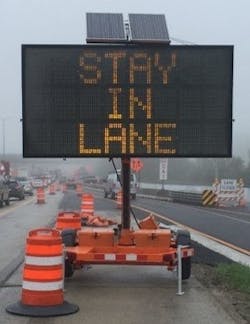Developments in traffic safety technology
Thinking about work zones, many people will immediately have a vision of long lines of orange drums.
Maybe they picture workers in hard hats and vests, heavy equipment, the sound of grinding, or the smell of hot mix asphalt. Planning and technology typically do not make it into the scene, although both play important and increasing roles in keeping everyone safe.
For a project, engineers need to review constructability, hours of work needed to complete different stages, traffic volume, safety, and other factors. With traffic volumes increasing each year across our highways, it is becoming more challenging to complete construction with little impact to traffic. The presence of work zones can greatly reduce capacity, causing delay and queueing. As a result, drivers are faced with transitioning from free-flow conditions to slow moving conditions, and sometimes a driver’s reaction is unpredictable.
Statistically we know that crashes increase in work zones. The most predominant crashes in work zones are rear-end (front-to-rear) crashes which typically occur at the end of the upstream queue.
To help reduce work zone crashes, the Wisconsin Department of Transportation (WisDOT) deploys Queue Warning Systems (QWS) to alert drivers of upcoming traffic conditions. The QWS is typically made up of a series of portable changeable message signs (PCMS) used to display messages to motorists upstream of the work zone, beyond the maximum queue. Traffic sensors detect real-time traffic speeds, and an automated traffic system which stores the data turns the warning message on and off based on a set of algorithms.
The system is real-time and activates only when traffic speeds drop below 40 mph; at all other times the system is inactive. When a portable traffic sensor detects speeds below 40 mph, the system activates the next upstream PCMS. The PCMS displays a message to alert motorists of stopped or slow traffic. Once the queue dissipates and speeds are back to free flow (above 50 mph), the PCMS are deactivated.
In 2015, the Federal Highway Administration (FHWA), announced smarter work zones as an Every Day Counts 3 initiative. WisDOT applied for a Federal AID grant to implement two QWS in Wisconsin to study the impact the system had on reducing rear-end crashes.
WisDOT completed a study in 2017 to determine the effect a QWS had on queue-related crashes. Queue-related crashes were compared with and without a QWS installed. Where a QWS was installed, the number of crashes decreased by 15% and the number of injury crashes decreased by 63%. A cost-benefit analysis found that the QWS reduced queue-related work zone crash costs by 13%. Reduced driver anxiety was another benefit of utilizing a QWS. The WisDOT study was consistent with other studies and experiences by other states.
The study shows that protecting the end-of-queue is an effective way to reduce crashes in work zones.
We then asked ourselves, are there other smart work zone devices that can make work zones safer and more efficient? Is there a way to provide drivers with information about how long the delay is? Is there a way to reduce the queue? Is there a way to get drivers to divert onto alternate routes?
Yes, there are a variety of smart work zone devices and technologies being implemented across the county that can achieve a safer and more efficient work zone.
The Dynamic Late Merge System (DLMS), often referred to as the ‘Zipper Merge’ in Wisconsin, is used to improve the flow of traffic on congested freeways to help reduce the queue. Through the use of PCMS, it encourages drivers to stay in the lane that will be closed until the merge point or the taper.
These systems are typically used when there is heavy congestion and traffic is either slow or stopped due to a single-lane closure as part of the work zone. When there is congestion, motorists are encouraged to use all lanes of traffic until reaching the defined merge area and then ‘take-turns’ merging from the closed lane.
There are several benefits to using these systems including an increase in overall throughput, uniformly distributed speeds per lane, reduction in the maximum queue length, and it alerts drivers of upcoming traffic conditions.
A DLMS is a series of PCMS, portable traffic sensors, arrow boards, and the automated traffic system. When WisDOT deploys the DLMS, it is always for a lane closure, which will cause some sort of queueing. WisDOT added the flashing beacon sign (FBS) to the DLMS to protect the end-of-queue. Instead of having two systems, the DLMS and QWS, WisDOT created a hybrid of the two. WisDOT incorporates the DLMS with FBS to alert drivers of stopped or slow traffic ahead and provide end-of-queue protection upstream.
Smart work zones continue to improve communication. Most drivers have experienced some sort of delay on our highways. Be it due to construction or incidents, drivers usually wonder how long the delay is or wish they could have gotten off at that last exit. This technology is now providing real-time, accurate travel-time information to help drivers make informed decisions when approaching and driving through work zones.
Travel time information can be reported for the time it takes to get through the end of the work zone or provide travel time along an alternate route. This comparison allows drivers to make the decision of which route to take. Providing travel time on an alternate route has the potential to increase the amount of diversion and decrease the overall volume passing through the work zone, creating a safer work zone with less delay. It is also beneficial to provide travel-time information to drivers prior to them entering a congested roadway to help mitigate additional delay.
One other crash mitigation site is where work zone egress/ingress are located along a stretch of roadway adjacent to travel lanes. Trucks carrying materials or equipment access the work zones through the designated areas, but often must decelerate or accelerate in a live lane of traffic as the work area may not provide enough space for a truck to safely do so. This can create sudden slowdowns in traffic without warning, causing crashes or other safety issues. To alleviate these concerns, a truck entering/exit warning system can be used to alert upstream drivers of trucks entering/exiting the roadway. This system consists of a sign, traffic sensors, and an automated traffic system and can be easily adapted to any work zone.
Smart work zone systems have been available for many years. They are increasingly being added to projects not only in Wisconsin but across the country. These systems are saving lives, reducing crashes, and providing real-time information about work zones. This makes work zones safer for the traveling public and workers. As new technologies emerge, like smart arrow boards and smart sensors, it will be crucial to test and deploy these devices to provide real-time lane closure information on our roadways to assist with connected autonomous vehicles and help human drivers navigate through work zones.


